The idea of perfectly manicured blocks of vibrant green lawns gives many of us the feeling of polished neatness. However, the investment of time, energy, and money to maintain a needy yard isn’t the best choice for everyone. The added pressure of more frequent droughts is becoming more common as well, urging us to move away from the traditional lawn. Even with enthusiasm and a green thumb, figuring out where to begin is overwhelming.
Beyond aesthetics, lawns are beloved spaces where kids and pets play and friends gather. Scrapping your grass will impact these recreational activities, so it’s important to think about what you want to do in your space. Alternatives can replace all or part of your lawn for a more eco-friendly yard, depending on how much space you are willing to transform. With some thoughtful design, you can save water and create a yard that works for you. If you feel ready for something more drought-tolerant, here are some grass alternatives to consider.
Plant a meadow
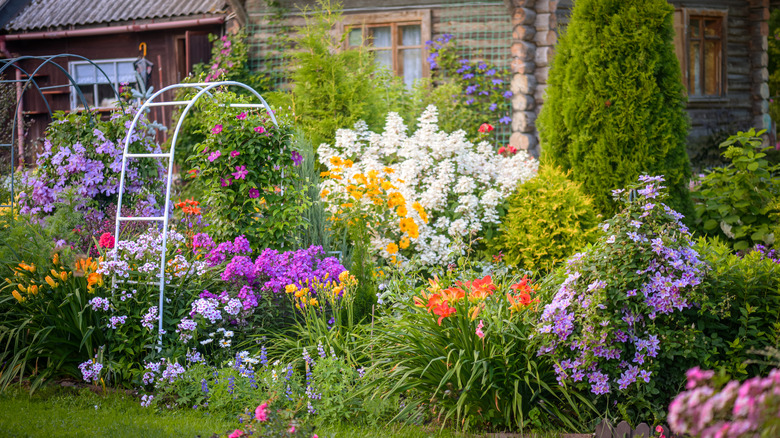
Lawns are monocultures that are frequently fertilized and then cut short, so they don’t offer much to wildlife as far as food and shelter. On the other hand, meadows created from native perennials and grasses feed and house the birds, the bees, and so much more. Plus, they require less water overall and are more resistant to drought because of their species variation.
The easiest way to start a meadow is to simply stop mowing. Many native plants will pop up on their own given enough time, but this method means that you don’t get to choose what grows. If you want to have some say in the when, where, and what, then the first step is to kill the grass. You can cut the first inch or so of soil back into sod pieces or kill everything with a plastic tarp.
Wildflower seed mixes are typically annuals and may have invasive species included, so for the best results, choose native perennials. It can take two to three years to truly establish itself. Once it does though, you won’t have to do much except mow it once a year.
Utilize groundcover
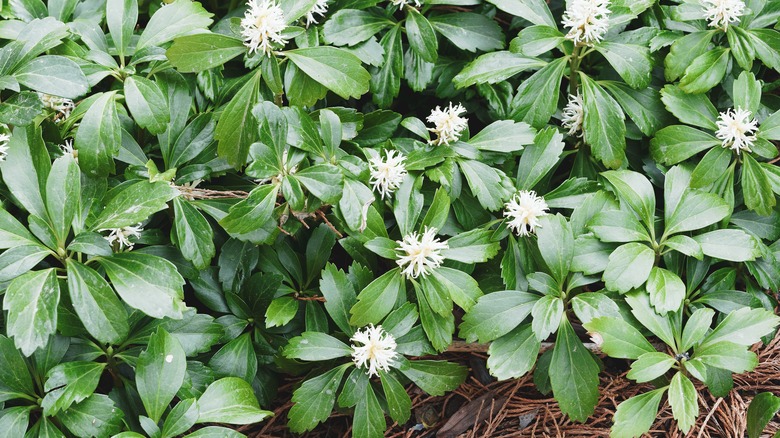
Replacing small patches of lawn with ground cover is an easy, though not always cost-effective plan. Popular varieties are sold as small plugs in flats, which is where the cost can add up quickly. Ground covers grow in mats, so you can utilize them to fill in larger areas than you could with individual plants. Plus, you do have some drought-resistant options.
Kurapia is a low-growing ground cover that doesn’t seem to mind a dry spell. While its parent plant, Phyla nodiflora, is a prolific spreader, this patented version is sterile. It can also handle some light recreation, making it one of the few ground covers flat and durable enough to be walked on. Watch out for the bees that are attracted to its small flowers though! When choosing a variety, avoid planting invasive species by doing a bit of research upfront. For example, English Ivy can be beautiful and fast-growing, but unless you stay on top of it, the vines can strangle trees and damage buildings.
Design with cacti and agaves
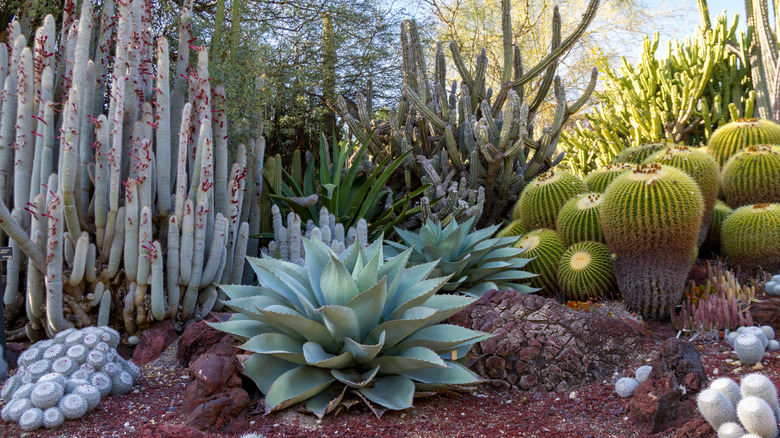
Sara Edwards/Getty Images
In hotter, drier climates, the trend of xeriscaping is gaining popularity. It’s a form of landscaping that specifically aims to eliminate the need for irrigation by utilizing rocks and native desert plants. By replacing a lawn with effective xeriscaping, people have reported saving on their water bill by 50-75%! You can aim for a xeriscaped yard anywhere, but the types of plants you will use will be region-specific. For those dry and sunny climates, you can’t go wrong with cacti and agave.
There are around 1,500 species of cactus in the world, and hundreds of them are native to the Americas. Cacti have evolved to store water in their fleshy stems and limit evaporation with their waxy skin. As you can imagine, this makes them extremely drought-tolerant. In fact, overwatering will kill them, so make sure you put them in full sun with well-draining soil. From a design perspective, they primarily come in two general shapes: flat (called oputunias) or columnar. To help them stand out as specimen plants, you can utilize other drought-resistant species and rocks around them.
Similar to cacti in terms of water retention and spikey danger levels, agave are beautiful focal plants in a xeriscaped garden. Their leaves tend to have some more variety than cacti too. Agaves can go weeks or months without water, and they are fire-retardant. Both are excellent selling points for hot and dry locations.
Landscape with drought-tolerant trees
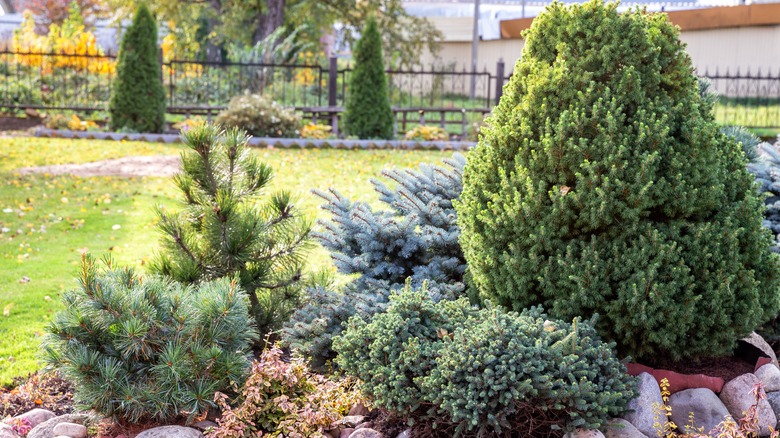
Yulia_B/Shutterstock
The slogan, “Plant a tree!” applies to replacing your grass too. Obviously, you don’t have to plant a forest to get rid of your lawn. One or two well-chosen trees can add intrigue and use less water in the long run. Climate change is a factor that we will be dealing with for the foreseeable future, and since trees typically live for decades, planning is essential.
While most drought-tolerant species just have adaptations that help them avoid damage during dry seasons, some do better than others. Junipers, for example, are excellent in dry, sunny spaces. They are so good at obtaining and using water from their environment that they can be easily over-watered in the wrong soil. From conical trees to spreading groundcovers, junipers come in various shapes, sizes, and colors, so you can work them into almost any landscape design.
Other species can handle short droughts as well, but they are region-specific. It’s important to note that planting trees is an investment. Young or newly transplanted trees will need more water while they get established in the landscape. However, once established, their deep roots and water-storing features will allow them to weather dry periods without permanent damage. You can pair them with shade-tolerant ground cover or perennial gardens for a woodsy feel.
Add native and ornamental grasses

Kyonntra/Getty Images
Native grass refers to species that grow naturally in an area. Ornamental grasses are the decorative plumes and spikes you can pick up in containers at your local nursery. Both can be used to replace or supplement your lawn, but they will still require some thought and effort to pull off. When it comes to putting down roots, the deeper, the better. Some native grass roots can reach 10 feet down into the soil, giving them plenty of access to groundwater. Compared to the extremely shallow roots of popular turfgrasses, access to an underground reservoir means they can handle drought longer.
Native and ornamental grasses tend to grow in clumps rather than flat swatches, so give them time to grow together. You may even want to treat them like landscape installations rather than a lawn substitute. Agrostis pallens, also known as Native Bent Grass, can be grown from seed into a resilient lawn with very low water needs. In terms of recreation, it can take a picnic, but you probably shouldn’t bust out the soccer ball.
To replace your lawn, start by tilling the soil and adding a bit of compost. When establishing new grasses, you want to water deeply less frequently, rather than the reverse of watering shallowly and more often. Also, go on a weeding frenzy as often as possible to ward off hostile takeovers.
Create a butterfly haven
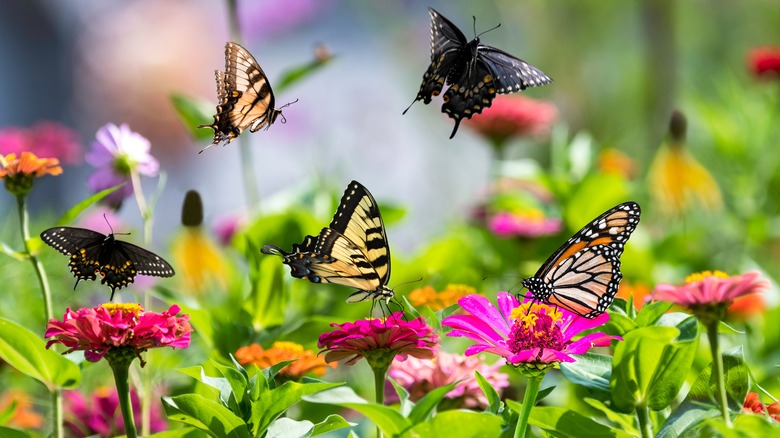
Georgi Baird/Shutterstock
We already mentioned all of the benefits that a wildflower meadow of native flowers and grasses could provide, but you can take it one step further and specifically create a yard catering to butterflies! Where a meadow is a little more uncontrolled, many of those native flowers can be planted individually in a manicured bed too. They will still have deep roots that help the plant adapt to water availability, so it is a win for drought tolerance.
To bring butterflies to your yard, you will need flowers. Many of the perennials sold in your local nursery will be perfect for this. Plants with bright flowers and nectar, such as Monarda, Nepeta, and Echinacea, feed the adult butterflies. Even non-native flowering shrubs, such as Physocarpus, can be useful in a drought-tolerant butterfly garden. Depending on your climate and how drought-tolerant you need your yard to be, you can also ramp this up to be a pollinator garden in general.
To keep butterflies in your yard, you will need food and shelter for their caterpillars. Luckily, many of these plants can also handle a dry environment. For example, butterfly weed (Asclepias tuberosa) is a preferred food source for Monarch butterfly caterpillars. Monarchs will stop for a drink from its orange flowers and deposit eggs on its leaves. With a deep taproot to source water and an affinity for dry, well-draining soil, it’s a perfect addition.
Enjoy a small herb garden
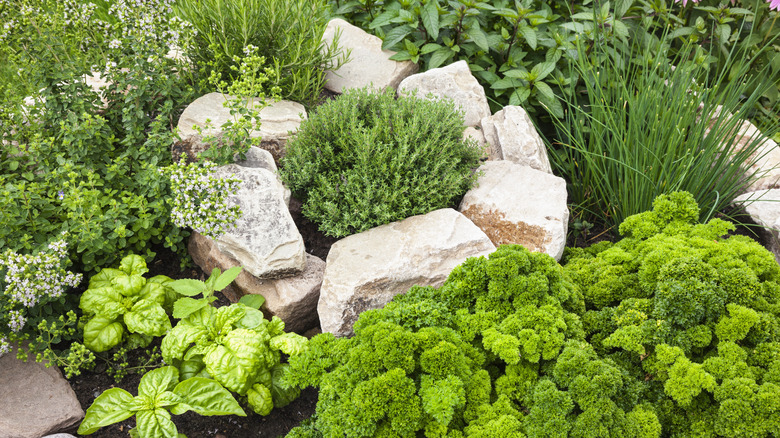
Michael1959/Getty Images
While veggie gardens do require regular watering, you can still dedicate part of your space to a small kitchen garden. Specifically, several of the most popular herbs actually do great during dry periods. During the hottest parts of the year, you may have to help them out with a drink, but they would appreciate not having wet roots most of the time!
Herbs such as lavender, rosemary, and thyme are versatile in both the kitchen and the garden. Lavender, with its lovely aroma and purple flowers, is a hardy perennial that does not like standing water. You can use it to cook, attract butterflies, and calm yourself down with a little aroma therapy. Rosemary is very similar in its need for well-draining soil and full sun. Companion planting it with a drought-resistant species of thyme works out well, and both plants will make your yard smell amazing.
An herb garden does not need to take up a lot of space. In fact, you can get by with planting your herbs in pots that you sit outside. To shrink your lawn though, planting the herbs together in either a raised bed or dedicated garden bed will yield good results. It’s important to pay attention to soil needs (well-draining vs. moist) and sunlight needs (full vs. partial) when creating a garden of any kind.
Install clever hardscaping
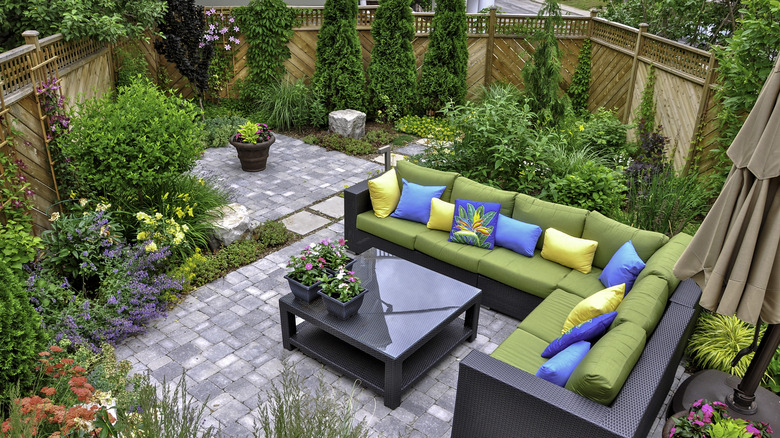
Joanne Dale/Getty Images
Hardscaping is the process of adding non-natural structures to the landscape, such as fire pits, patios, and retaining walls. Remember that adding more hardscape to your yard doesn’t have to be an all-or-nothing venture. In fact, ripping out your lawn and replacing it with a sea of concrete may cause more trouble by increasing stormwater runoff and urban heat. However, with some clever design that includes plants, permeable surfaces, and minimal structures, you can convert your yard into something more drought-tolerant and functional.
As far as what you can do, the possibilities are almost endless! For example, you can create multiple garden beds and connect them with a meandering flagstone path with gravel between the pavers. The gravel will allow water to sink into the ground rather than pooling on the surface, but you won’t have to mow it. Or you can plant a ground cover that wouldn’t do well with foot traffic around the pavers to get the best of both worlds. Perhaps you can shrink the size of your lawn and add a patio or deck for lounging. With less grass to water, you can save on water costs during a drought and still have a spot for kids and pets to play.
Considering synthetic materials
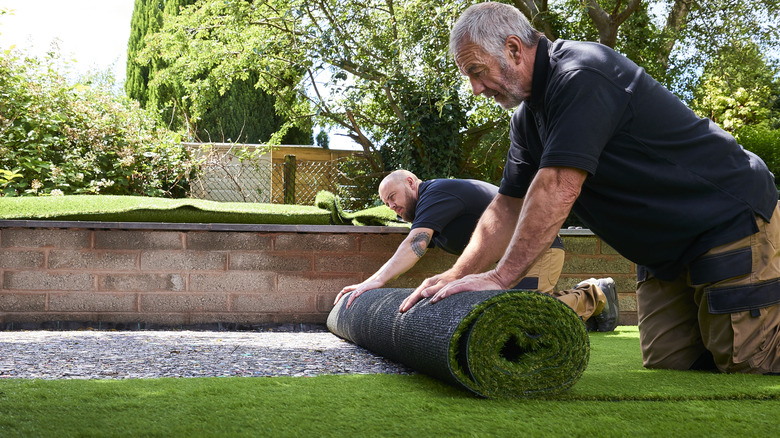
Martinprescott/Getty Images
At first glance, it’s understandable why replacing a living lawn by installing artificial turf or rubber mulch sounds like a good idea. Real grass uses a lot of water and needs to be mowed. Fake grass doesn’t. And the recreational aspect makes a faux lawn particularly appealing for playgrounds. Sadly, a solution this easy isn’t always as healthy or environmentally safe as we all wish it was. Some are made with non-biodegradable materials. So, once that artificial turf has exceeded its average lifespan of about 10 years, it is rolled up and disposed of in heaps in our already crowded landfills. Rubber mulch is often made from recycled tires, meaning that roadway filth is still lingering on them and then makes its way into your play area.
Instead, opt for artificial turf made from plant-based materials like sugar cane and soybeans. Or, look for fully recyclable options like the turf made by BuzzGrass. If you want to go the rubber mulch route, look for products like Rainbow Mulch that are tire-free, non-toxic, and tested to be compliant with safety standards.



